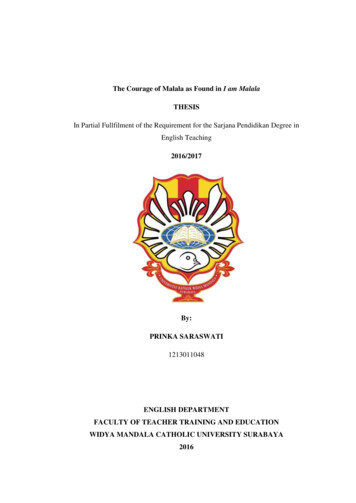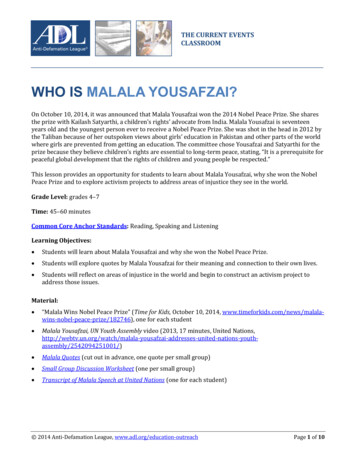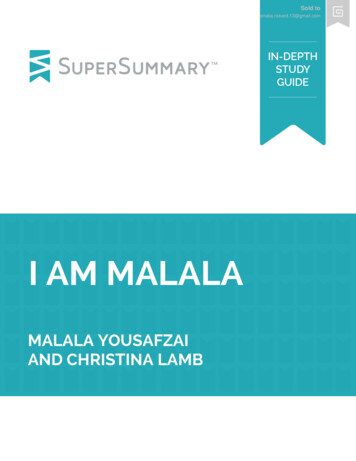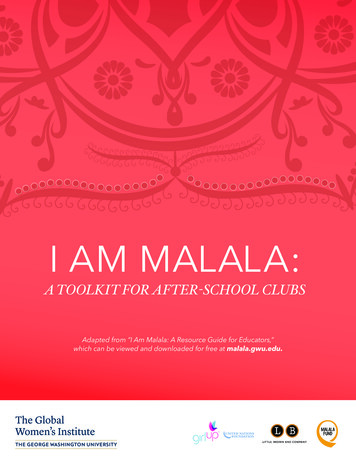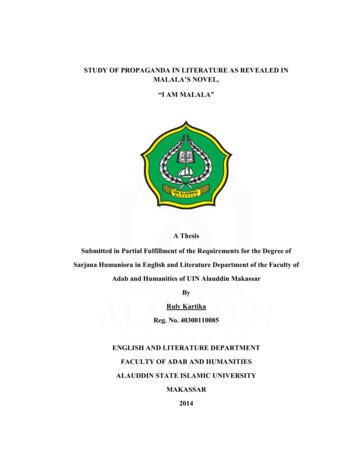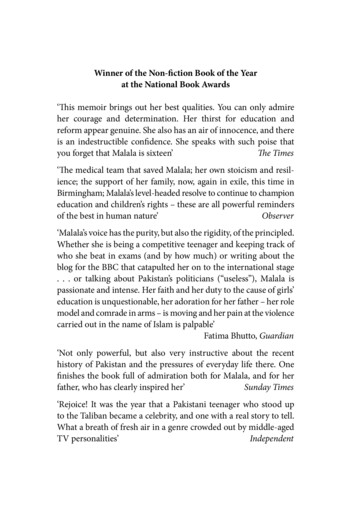
Transcription
I AM MALALA:A RESOURCE GUIDE FOR EDUCATORSTHEME 2:Education: A Human Right for GirlsFor more information or to submit feedbackabout the resource guide, visit malala.gwu.edu.
To expand the reach of Malala’s memoir—I am Malala: The Girl Who Stood Up for Education and Was Shot bythe Taliban—and spread Malala’s message to young people and activists, the Global Women’s Institute (GWI)of the George Washington University (GW), in collaboration with the Malala Fund, developed a resourceguide for high school and college students around the world. Building on the content of Malala’s memoir, theresource guide supports global efforts to mobilize women and men to address women’s and girls’ rights toan education.Malala’s memoir opens the door to some of the greatest challenges of our modern world. It is about politics,education, culture, religion and violence against women and girls. It is a moment in the life of a young girland in the history of a country. To do these broad themes justice, faculty from a wide range of disciplinescontributed to the development of the resource guide.The resource guide challenges students to think deeply, share their experiences, and engage with theircommunities. Each theme is divided into 4 parts: Part 1 is the narrative with learning objectives to frame the conversation and help plan lessons; Part 2 lists the resources to help students and teachers deepen their knowledge about the theme; Part 3 lists individual and group activities, including some to be done outside of class if studentsare interested; Part 4 is the high school supplement intended to help high school teachers introduce and discusssome of the concepts and context that appear in the theme narratives.Each part may be printed separately to be used by teachers or students.THE EIGHT THEMES ARE:1. Memoir as Literature and History2. Education: A Human Right for Girls3. Cultural Politics, Gender and History inMalala Yousafzai’s I am Malala4. Religion and Religious Extremism5. Malala and Violence against Women and Girls6. Malala Leadership Essay7. Malala and the Media8. Global Feminisms: Speaking andActing about Women and GirlsA Memoir by the YoungestRecipient of the NobelPeace Prize.To learn how to purchase thebook, visit malala.gwu.edu.
EDUCATION: A HUMANRIGHT FOR GIRLSBY MICHELE A. CLARK & LARISA WARHOLP A R T1NarrativeOn October 9, 2012, 15-year-old Malala Yousafzai was shotin the face on her way home from school. Her offense wasa deeply personal love of learning, accompanied by anequally passionate belief in the right to an education forgirls in Pakistan and beyond. This theme will consider theimportance of education for girls as a basic human rightthrough a discussion of the following issues: The status of girls’ education in Pakistan The international frameworks to ensure educationas a human right for girls The importance of education and schooling The challenges unique to educating girlsGirls’ Education in Pakistan“The School that my father dreamed of would have desksand a library, computers, bright posters on the walls and,most importantly, washrooms.”(Malala, Page 41)After independence, Pakistan inherited a British colonialschool system that has changed little in the past 65 years.According to the Constitution of Pakistan, the governmentis required to provide free and compulsory education forchildren ages 5 through 16, although this is not followed inpractice. The educational situation in Pakistan is complex.There are large disparities between urban and rural areasas well as social and economic classes and ethnic groupsrelated to access to school and school resources. Currentlya class-based education system is in place: high-qualityprivate schools for elites, low-cost private and public schoolsfor the poor, and madrassa schools for the poorest of thepopulation. In 2009, primary school attendance for theentire country was only 66 percent, well below the worldaverage of 90 percent.Many schools have large gender disparities. While there ismore gender equity in urban areas, rural areas experiencemuch gender inequality. In areas like the Swat Valley,after the Taliban in 2009 enacted a ban on the schoolingof girls, 400 private schools enrolling 40,000 girls wereclosed, including the private school run by Malala’s father,the Khushal School and College in Mingora. However,even after the Pakistani government regained control overthe region and reopened the schools, many girls did notreturn and Taliban insurgents still tried to prevent girlsfrom being educated. During this period, Malala becamean internationally recognized spokesperson for education,which resulted in her shooting by the Taliban. Since theeducation ban, national and international NGOs have beenworking to create more gender balance by opening “nonformal” schools (Latif, 2011). Malala, her family, civil societyorganizations, and the government continue working tooverturn the gender disparities and the social/culturalnorms against schooling women, especially since Islamurges both men and women to become educated.Overall, Pakistan suffers from common education challengesseen in both developing and developed countries: lack ofhighly qualified and trained teachers, outdated curricula,and a lack of education resources and materials (Ahmad etal., 2013). There are also challenges related to establishingthe role of religion in school curricula and determining thelanguage of instruction. Urdu is the language that differentpeoples and provinces in Pakistan use to communicatewith one another, whereas English is the official languageof the state and the language of higher education. At thesame time, education research promotes the use of locallanguages for cultural continuity and the cognitive benefitsof multilingualism.EDUCATION: A HUMAN RIGHT FOR GIRLS // 1
The efforts of Malala, her family, and the previous PPP andANP coalition government have brought some positivechanges to education in Pakistan (e.g., more tolerance andprotection of human rights and the inclusion of more secularnationalist leaders, movements, and historical figures). Inaddition, after Malala’s shooting, a U.N. petition promptedthe ratification by the Pakistani National Assembly of theRight to Free and Compulsory Education Bill of 2012, whichupholds the constitutional mandate of education for all andauthorizes fines for negligent schools and parents. Malala’sstory has brought worldwide attention to the ongoingchallenges and to the changes that need to take place toimprove education in Pakistan, especially for girls.Education as a Human Right for Girls“As we crossed the Malakand Pass, I saw a young girlselling oranges. She was scratching marks on a piece ofpaper with a pencil she had to account for the oranges shehad sold, as she could not read or write. I took a photo ofher and vowed I would do everything in my power tohelp educate girls just like her. This was the war I wasgoing to fight.”(Page 217)Malala’s commitment to education for girls is grounded inmodern international human rights discourse. Accordingto the United Nations Educational, Scientific and CulturalOrganization (UNESCO), education is considered a“fundamental human right” and “essential for the exerciseof all other rights.” The international community firstrecognized this in 1948 through Article 26 of the UniversalDeclaration of Human Rights, stating, “Everyone has aright to education.” The article affirms the right to free andcompulsory education in elementary school and the generalavailability of technical, professional, and higher education.Building on the universal declaration, numerous conventionshave affirmed the rights of children to “free, universal, andcompulsory education” with specific references to the rightsof girls. Notably, the Convention on the Elimination of AllForms of Discrimination Against Women (CEDAW) callsupon states to “take all appropriate measures to eliminatediscrimination against women in order to ensure them equalrights with men in the field of education.”The third Millennium Development Goal seeks to “promotegender equality and empower women,” but we are far fromseeing success. One hundred twenty-three million youngpeople worldwide still lack basic reading and writing skills,and girls comprise 61 percent of that number. While girlsare gaining access to primary education, gender disparitiesremain high precisely where education is able to help shapea young person’s future—at secondary and higher levels ofeducation. On her 16th birthday, July 12, 2013, in a speechbefore the U.N. General Assembly, Malala reminded theinternational community of its commitment to defend the2 // EDUCATION: A HUMAN RIGHT FOR GIRLSrights of education for girls and women by saying, “Todayis the day of every woman, every boy and every girl whoraised their voice for their rights.”Purposes of Education and Schooling“They can stop us going to school, but they can’t stopus learning.”(Page 161)Education is an integral and necessary part of anysociety. In modern times, it is most often associatedwith schools and the information learned in schools.As globalization encourages nations to form moderncapitalistic societies, much of what children need to knowto actively participate in these types of societies is taughtin schools. In postcolonial countries where there is oftenlinguistic and cultural diversity, schooling has also becomean important tool to build national unity and promotecitizenship through a national curriculum, such as the onedeveloped in Pakistan in 2006. Thus, education and schoolsimpart not only specific and relevant content knowledgeneeded for economic advancement but also integral socialknowledge needed for a cohesive society. This curriculumdiscarded rote learning for a greater focus on analyticalthinking and marked a modest shift toward removingmaterials that glorified war and incited conflict, ensuringgreater gender balance, and including references to localculture in textbooks. Critics of the revisions, however,believe that it did not go far enough and that it still projectsa biased interpretation of Pakistani culture. (EducationReform in Pakistan)Within global efforts for development, schooling isconsidered a foundational element for economicdevelopment and nation building. Education has becomea common world agenda item, as seen in the “Educationfor All” (EFA) movement, which has focused on ascertainingdemographic trends and examining the overall benefits of,and constraints to, education in the developing world. EFA,led by UNESCO, releases an annual monitoring report andhas also developed the Global Partnership for Education,which helps low-income countries achieve free anduniversal primary education. EFA directly relates to MDGsthat emphasize that education is a human right, and it has apositive impact on the economic development of the localand national communities. EFA also endorses increasedfemale empowerment and gender equity. This consensus issolidified by the United Nations’ unprecedented emphasison girls’ and women’s empowerment and human capitalinvestment as the condition of development in the eightMillennium Development Goals.
The Challenges of Educating Girls“I believe that female teachers should educate girls butfirst, we need to educate our girls so that they can becometeachers!”(Page 118)Traditional studies promoting education for girls focuson the positive impact of education for their future wellbeing. In particular, benefits include higher wages, greaterparticipation in public/political life, later marriages, andfewer, healthier, and better-educated children. Thesebenefits, however, are offset by a broad spectrum ofchallenges, which need to be addressed by policymakers,donors, and local activists. Many obstacles are rootedin culture and tradition and keep girls in a worldviewwhere education plays no part in their futures. While stillin elementary school, Tor Pekai, Malala’s mother, stoppedgoing to classes because, simply put, she did not see thevalue to an education. “There seemed no point in going toschool to just end up cooking, cleaning, and bringing upchildren, so one day, Pekai sold her books for nine annas,spent the money on boiled sweets and never went back. Herfather said nothing.” (Page 40)Religious tenets in many parts of the world further define awoman’s place as caring for her husband and children andnot interacting with men outside of her immediate family,factors which limit a woman’s professional opportunities.The lack of female teachers creates an obstacle to educatinggirls where fears of sexual harassment as well as socialtaboos in mixing the sexes constrain girls’ attendance. Andfinally, a family’s economic status will determine whetherresources will be invested in educating sons or daughters.Malala illustrates this boy preference when she describeshow school “wasn’t the only thing my aunts missed out on.In the morning, when my father was given cream or milk, hissisters were given tea with no milk. If there were eggs, theywould be only for the boys. When a chicken was slaughteredfor dinner, the girls would get the wings and the neck whilethe luscious breast meat was enjoyed by my father and mygrandfather.” (Page 29)Evidence is now emerging to indicate that not only girlsbenefit from getting an education. According to a 2011World Bank study, Measuring the Economic Gain ofInvesting in Girls, “Improving the socio-economic outcomesfor girls and young women is of central importance, notonly to the beneficiaries themselves but also to theircommunities and the next generation.” This conclusion is atthe heart of Malala’s message and creates a challenge for allof us as academics, activists, and global citizens.EDUCATION: A HUMAN RIGHT FOR GIRLS // 3
P A R T2ResourcesArticles and ReportsAhmad, I., Rauf, M., Rashid, A., Rehman, S. & Salam, M.(2013). Analysis of the Problems of Primary EducationSystem in Pakistan: Critical Review of the Literature.Academic Research International, 4 (2), 324-331.Bengali, K. (1999). History of Educational Policy Making andPlanning in Pakistan. The Sustainable Development PolicyInstitute: Working Paper Series #40.Chaaban, J. & Cunningham, W. 2011. Measuring theEconomic Gain of Investing in Girls: The Girl Effect Dividend.Policy Research Working Paper 5753. Washington, D.C.: TheWorld Bank.Hameed-ur-Rehman, M. & Moosa Sadruddin Sewani,S. (2011) Critical Analysis of the Educational Policies ofPakistan. The Dialogue, VIII, 3.Lafit, A. (2011). Alarming Situation of Education in Pakistan.UNESCO: Press International Report.4 // EDUCATION: A HUMAN RIGHT FOR GIRLSLevine, R. et al. (2008). Girls Count: A Global Investment& Action Agenda. Washington, D.C.: Center for GlobalDevelopment.Malhotra, A. et al. 2003. Impact of Investments in FemaleEducation on Gender Equality. Washington, D.C.:International Center for Research on Women.Education Reform in Pakistan, Asia Report No. 257,June 2014, International Crisis Group, Belgium availableat http://www.crisisgroup.org/ n-reform-in-pakistan.pdfInternational Conventions Related to Education The Convention on the Elimination of All Forms ofDiscrimination Against Women (CEDAW) The United Nations Declaration of Human Rights The Millennium Development Goals
P A R T3ActivitiesINDIVIDUAL ACTIVITIESA. The role of incentives in encouragingschool attendance.Malala’s mother stopped going to school because shedid not see the relevance of an education for her ownfuture. Her parents did not challenge her decision, andthe community offered no incentive to educate girls eitherthrough opportunities for employment or increased socialstatus. However, research now indicates that raising afamily’s income will increase a boy’s chance for stayingin school by 16 percent, and 41 percent for girls. Manyeducational initiatives now offer financial compensation toparents to keep their daughters in school. Write a two-pagepaper arguing for the value of such incentives as a longterm strategy to keep girls in school. Are there environmentswhere financial incentives work better than others?B. What would Malala say?Millennium Development Goal 3 focuses on promotinggender equality and empowering women. A target ofthis goal is to “eliminate gender disparity in primary andsecondary education, preferably by 2005, and in all levelsof education no later than 2015.” (http://www.un.org/millenniumgoals)Write Malala’s next speech to the U.N. General Assemblyin the fall of 2015, in which she addresses the status ofMDG 3. What recommendations will she make to the U.N.bodies in order to ensure that the aims of the goals will beaccomplished? Draw on Malala’s efforts and activities asillustrated in her book. Limit: 1,000 words.GROUP ACTIVITIESC. Debate: Is education a human right?Malala appeared in front of the United Nations and paidhomage to all girls, boys, and women who claimed theirright to an education. Primary schooling is specifically citedas a right in international conventions, and states are alsoencouraged to provide for secondary and higher education.But does educating children beyond primary school carrywith it the same duties and obligations as other rights?Using Malala’s experience as a starting point, divide theclass into two groups and debate the question, Shouldstates be held accountable for education of their childrenand youth?D. Gender analysis on education inPakistan group projectIn small groups of three or four people, you will beconducting a gender analysis of education in Pakistan. UsingMalala’s memoir as a primary source, you will write a twopage policy brief including recommendations to inform adonor-funded program to support gender-based educationdevelopment projects in Pakistan.Your brief should cover USAID’s Six Domains of GenderAnalysis (see right column), and your recommendationsshould address the following questions: What are key gender issues that might affect the abilityof a project to achieve its goals or prevent women andmen from benefiting equally? Does the gender analysis suggest that without anyproactive intervention there will be gender imbalancein projects? What types of data should be collected to track thegender-related project impacts? What might be some potential unintendedconsequences?Your gender analysis should use as your primary sourceMalala’s memoir.It should also include an investigation of secondarysources related to Pakistan’s laws, policies, and institutional,social, and religious practices and/or other research reportsand literature.EDUCATION: A HUMAN RIGHT FOR GIRLS // 5
USAID’S SIX DOMAINS OF GENDER ANALYSISSource: USAID Tips for Conducting aGender Analysis at the Activity or Project ments/1865/201sae.pdfAccessThis domain refers to a person’s ability to use the necessaryresources to be a fully active and productive participant(socially, economically, and politically) in society. It includesaccess to resources, income, services, employment,information, and benefits.Knowledge, Belief, and PerceptionsThis domain refers to the types of knowledge that men andwomen possess, the beliefs that shape gender identities andbehavior, and the different perceptions that guide people’sunderstanding of their lives, depending upon their genderidentity.Practices and ParticipationThis domain refers to people’s behaviors and actions in life—what they actually do—and how this varies by gender rolesand responsibilities. The questions cover not only currentpatterns of action but also the ways in which men andwomen may engage differently in development activities.Types of action include attendance at meetings and trainingcourses, and accepting or seeking out services. Participationcan be both active and passive.6 // EDUCATION: A HUMAN RIGHT FOR GIRLSTime and SpaceThis domain recognizes gender differences in the availabilityand allocation of time and the locations in which time isspent. It considers the division of both productive andreproductive labor; the identification of how time is spentduring the day (week, month, or year, and in differentseasons); and how men and women each contribute to thewelfare of the family, community, and society. The objectiveof this domain is to determine how men and women spendtheir time and what implications their time commitmentshave on their availability for program activities.Legal Rights and StatusThis domain involves assessing how people are regardedand treated by customary legal codes, formal legalcodes, and judicial systems. The domain encompasseslegal documentation such as identification cards, voterregistration, and property titles.Additionally, the domain includes the right toinheritance, employment, atonement of wrongs, andlegal representation.
P A R T4Supplemental Information for High SchoolEducation: A Human Right For GirlsESSENTIAL QUESTIONS:1. How do you think that educating girls can benefit atown? A community? A country?2. In your own life, what are the benefits of youreducation to the following: You, as a person? Yourfamily? Your community? Your state? Your country?CONTEXTWhat is the United Nations?The United Nations (UN) is an international organizationfounded in 1945 at the conclusion of World War II, toprovide a forum for member states to resolve challengesrelated to the relationships among countries. According tothe UN website, the organization has four purposes:1. To keep the peace throughout the world.2. To develop friendly relations among nations.3. To help nations work together to improve the livesof poor people, to conquer hunger, disease andilliteracy, and to encourage respect for each other’srights and freedoms.4. To be a center for harmonizing the actions of nationsto achieve these goals.Who protects human rights?According to the UNHCHR, “International human rights lawlays down the obligations of government to act in certainways or to refrain from certain acts, in order to promoteand protect human rights and fundamental freedoms ofindividuals or groups.”Therefore, it is the responsibility of the State to protectindividual human rights. The Universal Declaration ofHuman Rights is not a treaty, and therefore the terms are notbinding to UN member States. However, the Declaration hasbecome a significant rallying point in international humanrights discourse.http://www.ohchr.orgWhy is gender equality in education important?On an individual level, education opens the doors toimproved prospects for employment and financialindependence. On a social level, education helps to ensureeconomic development as well as political and socialstability. According to UNICEF, “ girls’ education hasproven to be one of the most cost-effective strategies topromote development and economic growth.”http://www.unicef.org/esaro/5481 girls education.htmlThere are currently 193 UN member states.Why does the lack of female teachers make a difference?http://www.un.org/en/abutunThe lack of female teachers can create an obstacle to girls’education for many reasons. In some cultures, young womenare allowed to be taught only by other women and thereforewill not be allowed to sit in another classroom with maleteachers. In other environments, a majority of male teachersdeprives girls of favorable role models and discouragescommunities from recognizing the value of girls’ education.How are human rights defined?According to the United Nations High Commissioner forHuman Rights (UNHCHR), human rights are “rights inherentto all human beings, whatever our nationality, place ofresidence, sex, national or ethnic origin, color, religion,language or other status.”http://www.ohchr.orgEDUCATION: A HUMAN RIGHT FOR GIRLS // 7
KEY TERMS OR NAMESThe Universal Declaration of Human Rights: The UniversalDeclaration was adopted by the General Assembly of theUnited Nations on 10 December 1948. It declares thathuman rights are universal and includes civil and politicalrights. These include the right to life, liberty, free speech andprivacy. It also includes economic, social and cultural rightssuch as the right to social security, health and education.Millennium Development Goals: The MillenniumDevelopment goals form a blue print agreed to by allthe countries and all the world’s leading developmentorganizations for meeting the needs of the world’spoorest inhabitants.These goals are:1. To eradicate extreme poverty and hungerAchieve a 50% improvement in adult literacy by 2015,especially for women, and equitable access to basic andcontinuing education for all adults.Eliminate gender disparities in primary and secondaryeducation by 2005, and achieve gender equality ineducation by 2015, with a focus on ensuring girls' fulland equal access to and achievement in basic educationof good quality.Improve all aspects of the quality of education andensure the excellence of all so that recognized andmeasurable learning outcomes are achieved by all,especially in literacy, numeracy and essential life /brief/education-for-all2. To achieve universal primary education3. To promote gender equality and empower women4. To reduce child mortality5. To improve maternal health6. To combat HIV/AIDS, malaria and other diseases7. To ensure environmental stability8. To develop a global partnership for development.For information on the implementation of theMillennium Development Goals, visit http://www.un.org/millenniumgoals/bkgd.shtml.1. Education for All Movement (EFA): According tothe World Bank, “Education for All” (EFA) is aninternational initiative first launched in 1990 tobring the benefits of education to “every citizen inevery society.”The EFA consist of a broad coalition of stakeholderscommitted to working together to help achieve thefollowing education goals:Expand and improve comprehensive early childhoodcare and education.Ensure that by 2015 all children, particularly girls, thosein difficult circumstances, and those belonging to ethnicminorities, have access to and complete, free, andcompulsory primary education of good quality.2. Global Partnership for Education: The GlobalPartnership for Education (GPE) is an internationalorganization that focuses on supporting countries’efforts to educate children from early primary schoolthrough secondary school. Its goals include ensuringgender parity in education, building and equippingclassrooms and training s3. Convention on the Elimination of all forms ofDiscrimination Against Women (CEDAW): TheConvention on the Elimination of All Forms ofDiscrimination Against Women (CEDAW), adoptedin 1979 by the UN General Assembly, is an“international bill of rights for women.”http://www.un.org/womenwatch/daw/cedaw/4. United Nations Educational, Scientific, and CulturalOrganization (UNESCO): UNESCO was establishedin 1945, in the aftermath of World War II, upon thebelief that “Peace must be established on the basisof humanity’s moral and intellectual solidarity.” It isoften referred to as the “intellectual agency of theUnited Nations.http://en.unesco.orgEnsure that the learning needs of all young people andadults are met through equitable access to appropriatelearning and life-skills programs.We would like to thank Michele Clark, Larissa Warhol,Judy Rogers, and Fernanda Bianchi for their contributions to the high school supplement.For more information or to submit feedback about the resource guide, visit malala.gwu.edu.8 // EDUCATION: A HUMAN RIGHT FOR GIRLS
To epan the reach of Malala’s memoir am alala The irl ho tood p for ducation and Was hot b the Taliban—an sprea Malala’s message to young people an actiists the lobal Womens nstitute WI) of the eorge Washington niersity W), in collaboration ith the Malala un eelope a resource guie for high school an college stuents aro
